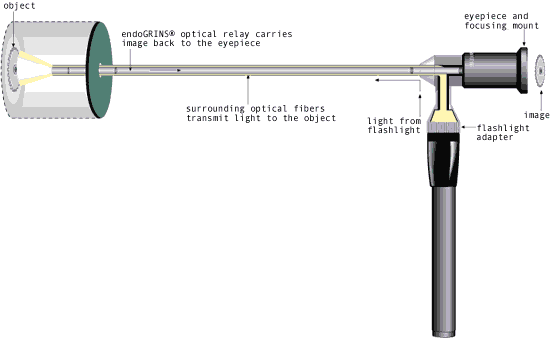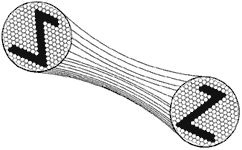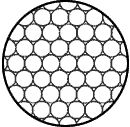How Borescopes Work
Rigid Borescopes

| The heart of a borescope design is the relay lens system. Gradient Lens Corporation's new endoGRINS® design has made that easier and less costly. |

| The first optical design used for relays was the achromatic doublet. A series of lens pairs form and reform images, each image the subject for the next relay set. The spacing between series is proportional to the diameter of the lenses, so this color-corrected design works quite well for larger diameter borescopes. The Hawkeye Blue rigid borescopes 5.8mm diameter and above use this design.
Small diameters borescopes using an achromatic doublet design need far too many lenses, too close together and image quality becomes poor.
|

The achromatic design was improved upon by H.H. Hopkins who patented a new design in 1966. H.H. Hopkins' design combined conventional lenses with short, optical-glass rods to give higher brightness, accentuated color, higher contrast, and sharper images when compared to the achromatic doublet relay of the same diameter. This conventional design is typically used in top of the line small diameter borescopes and is used in all Hawkeye Blue rigid borescopes under 5.8mm in diameter, resulting in superb image quality.
|
Innovative endGRINS® gradient index relay

| Gradient Lens Corporation developed the Hawkeye® Precision Borescope using endoGRINS® gradient index lenses, combined in a patented design of elegant simplicity and excellent optical quality. EndoGRINS lenses are longer optical glass rods treated in an ion exchange process. Cost savings are large. Expensive micro-lenses which had to be ground, polished, coated, and centered can simply be replaced with several glass rods. The Hawkeye borescopes were launched with quality and prices that guaranteed their success. |
Flexible Borescopes
Flexible and rigid borescopes have a lot in common. Each have objective lenses to form an image of the subject on the relay system. Each have eyepiece lenses to magnify the image from the relay system so you can see it.
The difference is in the relay itself.
To allow flexibility the image is carried from the objective lens to the eyepiece by a bundle of optical fibers, instead of a system of lenses. Light cannot escape through the side once it enters a fiber, so it follows the fiber around twists and bends.
 The ends of the fibers must occupy precisely the same respective positions at both the lens and eyepiece ends, or the image would be "scrambled."
The ends of the fibers must occupy precisely the same respective positions at both the lens and eyepiece ends, or the image would be "scrambled."
 The resolution of a flexible borescope depends on the number of fibers and their diameter. More fibers of smaller diameter give higher resolution. They also increase the cost of the scope.
The resolution of a flexible borescope depends on the number of fibers and their diameter. More fibers of smaller diameter give higher resolution. They also increase the cost of the scope.